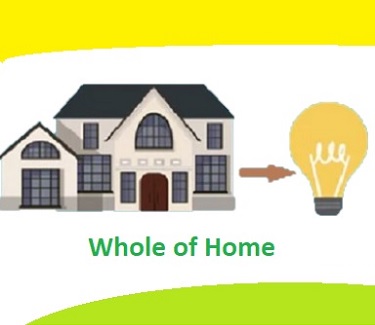Whole of Home Assessment
The focus of previous versions of NCC Vol 2 (for the residential dwellings) was to improve the building’s thermal performance through insulation and improved glazing. This approach was passive due to its focus being on the performance of the building envelope and not the building services. In the new NCC 2022 Vol 2.0, a Whole of Home (WoH) approach has been introduced. This feature considers the efficiency of energy-using services and On-site electricity generation and use via solar PV system.

What is Whole of Home assessment?
The objective of Part H6 Energy Efficiency provisions of the New NCC 2022 is for Class 1 and Class 2 buildings to:
The new Whole of Home assessment approach ensures that all the above is considered in new-built homes in Australia. The holistic approach of the new NCC 2022 not only considers the performance of the building envelope but also considers the efficiency of building services and the impact of renewables on electricity use reduction.
What are Whole of Home requirements?
Energy consultants undertake Whole of Home (WoH) assessment to achieve compliance with Part H6P2. This part of NCC Vol 2 includes the Performance Requirements for the energy use of domestic services. These domestic services include the equipment used for:
- Space heating and cooling
- Mechanical ventilation
- Artificial lighting
- Pool and spa pump and heaters
- Heated water supply
- On-site renewable energy systems
And excludes:
- Cooking appliances and portable appliances
The new WoH assessment ensures that these domestic services are efficient or help to reduce the peak energy demand and greenhouse gas emissions, as well as reducing their impact on the energy network. WoH requirements are outlined in:
- NCC Vol 2 Part 13.6.2 for new residential dwellings (Class 1 buildings)
- NCC Vol 1 Part J3D14 for new apartments (Class 2 buildings)
Note: The WoH requirements for apartments are slightly easier to achieve compared to those for houses.

WoH requirements are flexible and no set of rigid rules can be applied to all projects. The metric used here is “Net Equivalent Energy Usage”. This means that you can choose how to achieve a Net Equivalent Energy Usage target; as an example, for a house in Melbourne with a floor area of 150m2 and no pool/spa, you can achieve compliance with Part 13.6.2 (Whole of Home) by following either of the options below and many more:
Option A
5.5-star non-ducted heat pumps*
Heat pump water heater
No photovoltaics
Option B
3.5-star non-ducted heat pumps*
Solar-assisted gas water heater
No photovoltaics
Option C
3.5-star non-ducted heat pumps*
Instantaneous gas water heater
1.2 kW photovoltaic system

How do you undertake Whole of Home assessments?
There are two options available for houses and apartments to satisfy the requirements of Whole of Home. These options are both Deemed to Satisfy (DtS) pathways and include:
Whole of Home Compliance steps

NatHERS Whole of Home Assessment
After the determination of the thermal performance of the proposed building using NatHERS-accredited tools (e.g. FirstRate5), the model file must be uploaded to be prepared for obtaining a certification. At this stage, the model could also be imported through the Whole of Home platform to determine the performance of building services. The thermal performance of the house and services are combined and the energy usage of the Whole of Home is calculated. If the energy usage is less than or equal to the energy use budget, then the proposed building is eligible for certification.
Following the new NCC 2022, building services are also required to be taken into account. To obtain NatHERS certification, information about the following building services is required:
- Space heating and cooling equipment
- Hot water supply systems
- Pool/spa pumps
- Cooking
- Lighting and plug-in appliances
- On-site energy generation and storage
Whole of Home rating
After the basic information and efficiency data for the services are entered, a Whole of Home rating could be produced, scaling from 0 to 100; While rating of 100 means that the building produces the same amount of energy it consumes. The rating could go beyond 100 if the building generates more energy than it consumes. The new houses and townhouses require a Whole of Home rating of 60 and new apartment units require a rating of 50 before being certified.
The output of this Whole of Home assessment is a summary report that includes several valuable metrics:
- Energy Use: the net energy use of all end-uses of appliances that also includes the offset due to the electricity generation of solar PV systems and the storage of batteries. This metric is reported in Megajoules (MJ) and includes all energy sources (e.g. gas and electricity).
- Greenhouse Gas Emissions: the net greenhouse gas emitted due to the use of building services, including photovoltaics. This metric is reported in Tonnes.
- Energy Cost: depending on the state and territory in which the proposed building is located, energy tariffs are multiplied by energy use to produce the energy cost of individual services. This also includes the supply charges.
- Energy Value: this is the cost of all appliance end-uses and offsets by photovoltaics and battery that also includes the cost of carbon; which is the cost of dealing with the impact of greenhouse emissions produced by the building services.
- Target Energy Value: Target energy value is the calculated energy value for a 7-star reference dwelling with the same floor area as the proposed building under assessment.
- Whole of Home rating: this is the final generated score, calculated from the Target and Net Energy Value. For residential dwellings and townhouses, a minimum rating of 60 and for apartment units, a minimum rating of 50 is required.
